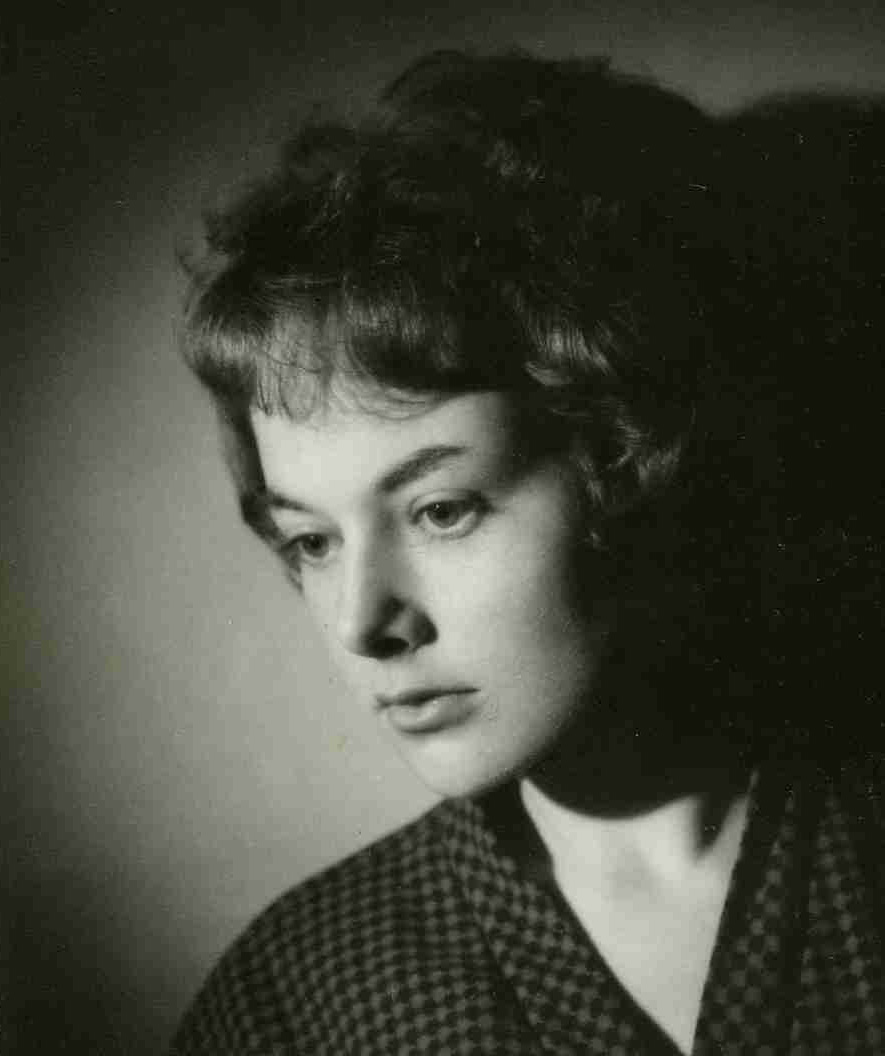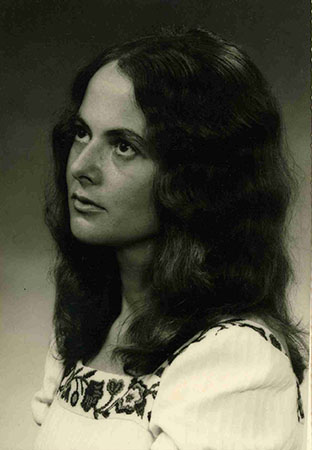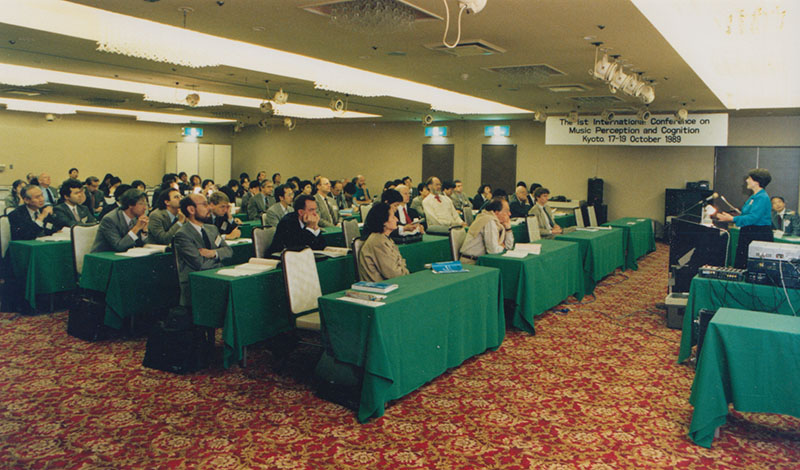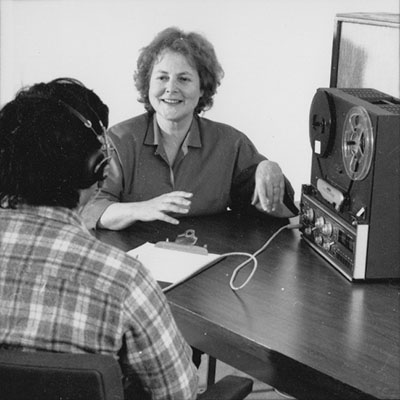| |
Biography


Diana Deutsch
Diana Deutsch was born in London on February 15, 1938. Her father was a sculptor, and during her childhood she spent long hours watching him and other artists at work in their studios, and listening to their animated discussions concerning the relationships between art, science, and philosophy. She attributes her dedication to the synthesis of art and science to these experiences in her early years. Deutsch’s musical talent was recognized early, and she studied music intensively during childhood and adolescence. However, having won a scholarship to Oxford University, she entered St. Anne’s College, Oxford in 1956, and obtained a First Class Honors B.A. in Psychology, Philosophy, and Physiology in 1959.
When at Oxford, Deutsch was particularly influenced by lectures on philosophy by J.L. Austin, and by discussions on cognitive psychology with Stuart Sutherland, and visual illusions by Richard Gregory. She married J. Anthony Deutsch in 1957, and in 1959 they together moved to the U.S. During the next few years they together wrote the textbook Physiological Psychology, and also wrote the article ‘Attention: Some Theoretical Considerations’ that first proposed the ‘late selection’ theory of attention; this theory has influenced much later work on attention.
In 1966 Deutsch entered the Ph.D. program in Psychology at the University of California, San Diego. At the time, it had just become possible to create musical sounds with versatility and precision, and Deutsch made use of this new technology to study memory for sequences of tones. This work, together with further work that she later carried out, showed that memory for pitch is the function of a specific and well organized system – a finding that ran counter to prevailing beliefs about memory. Also while in graduate school, Deutsch proposed one of the first neural networks for musical shape recognition; this has formed the basis of more elaborate models later developed by others. Deutsch obtained her Ph. D. in 1970, and accepted the position of Research Scientist in the Psychology Department in 1971. In 1989 she was appointed Professor of Psychology – a position she currently holds.
Research

After setting up her research lab, Deutsch developed a paradigm in which two different sequences of tones were repeatedly presented to the listener via headphones, such that when the right ear received one sequence the left ear received the other sequence. She found, to her surprise, that striking illusions occurred under these conditions; for example she discovered the octave illusion, thescale illusion, the chromatic illusion, thecambiata illusion, and theglissando illusion, among others. She found not only that were such sequences rarely heard correctly, but also that there were striking differences between listeners in terms of what they perceived. These perceptual differences varied in correlation with the listener’s handedness, and so reflected variations in brain organization.
Later Deutsch discovered another class of illusions, using simple sequences of tones whose note names were clearly defined, but which were ambiguous in terms of what octave they were in. For example she discovered the tritone paradox. To produce this illusion, Deutsch presented two such tones in succession which were related by a half-octave, and found that, as with the stereo illusions, there were large individual differences in how this pattern was perceived: When one person heard the pattern as ascending in pitch, another person heard the same pattern as descending. In this case, the perceptual differences depended on the listener’s language or dialect, which in turn correlated with the pitch range of his or her speaking voice, so reflecting a connection between music and speech. Deutsch also discovered the speech-to-song illusion, in which a spoken phrase was made to be heard as sung rather than spoken without altering it in any way, but simply by repeating it several times over. This effect also indicated a strong connection between speech and music.
Deutsch also has a long-standing interest in the influence of our experience, beliefs, and expectations (i.e. ‘top-down processing’) on what we hear. She first showed this in her ‘mysterious melody’ illusion. She later showed the same general influence in her ‘phantom words’ illusion: Here she repeatedly presented two-syllable words and phrases via stereo loudspeakers, such that when one word was presented from the speaker on the right the other word was presented from the speaker on the left, with the words switching back and forth between speakers. After continued listening to this cacophony of sound, people generally began to hear words and phrases that were not really there. Often the speech that was ‘heard’ had some particular meaning to the listener, and Deutsch concluded that these ‘phantom words’ were generated by the brain in an attempt to extract meaning from the chaos of sound that was presented.

Deutsch has recently focused much of her research on the question of absolute pitch (or perfect pitch), which is the ability to name or produce a musical note of particular pitch in the absence of a reference note. She began this line of research when she noticed that, for speakers of tone language, the pitch levels at which spoken words were pronounced were very important to conveying their meaning. In one study, she and co-authors showed that speakers of tone languages (Mandarin and Vietnamese) were remarkably consistent in the pitches with which they pronounced the same list of words on different days. This led to further large-scale studies in which she and co-authors showed that the prevalence of absolute pitch, which is very rare in the Western world, is common among musicians who are speakers of Mandarin. Further studies showed that this effect is not genetic in origin. From these findings Deutsch argued that that, if given the opportunity, infants can acquire absolute pitch as a feature of speech, which can then carry over into music. Since speakers of nontone language such as English are not generally given the same opportunity to associate pitches with verbal meanings very early in life, absolute pitch would for them be much less common. In considering why some rare nontone language speakers possess this faculty, Deutsch and Dooley have recently found that, among speakers of English, absolute pitch was correlated with the possession of a large auditory digit span. A strong memory for spoken words could foster the development of associations between musical notes and their names in early childhood, and so facilitate the acquisition of absolute pitch.
As a further issue, Deutsch has explored short-term memory for pitch. She has shown that memory for the pitch of a tone is retained in a specialized system, which is organized precisely and systematically. Most of these studies employed a paradigm she developed in which subjects were presented with two test tones that were separated by a sequence of intervening tones; the subjects judged whether the test tones were the same or different in pitch. In one study, she showed that while a sequence of intervening tones disrupted pitch memory, a sequence of spoken numbers produced little or no disruption. In other studies she found that memory for the pitch of a tone was subject to interference effects that depended on the pitch relationships between the tone to be remembered and those in the intervening sequence. In yet other studies she showed that errors in pitch memory judgment can result from loss of information as to when, in a sequence, a tone had occurred. In further experiments, she investigated interactions between the system underlying memory for pitch and those underlying memory for other attributes, such as melodic and harmonic intervals, and spatial location. From a different perspective, Deutsch collaborated with the mathematician John Feroe to develop a theoretical model in which pitch sequences are represented by the listener as hierarchical networks. In this model, elements that are present at each hierarchical level are elaborated by further elements so as to form structural units at the next lower level, until the lowest level is reached. This model has been used as a basis for further, more elaborate models that were later developed by others.

Other Activities
At the time Deutsch began researching the psychology of music, the empirical study of music was in its infancy. Deutsch promoted the field through many professional organizations, where she gave invited lectures and organized symposia, for example, at the American Association for the Advancement of Science, the Acoustical Society of America, the American Psychological Society, the American Psychological Association, and the Audio Engineering Society. She often placed this new field in historical context, for example in her book chapter Psychology and Music, in which she argued against the prevailing rationalistic approach to musical issues. She was involved in organizing a series of interdisciplinary meetings on the Physical and Neuropsychological Foundations of Music, and those who attended these meetings formed the nucleus of this new field. In 1989, Deutsch co-founded the International Conference on Music Perception and Cognition – a biennial series of conferences- and served as the Co-Chair of the Organizing Committee of its first meeting, which was held in Kyoto. Then in 1990, Deutsch founded the (American) Society for Music Perception and Cognition, and served as its Founding President in 1990-1992, continuing as President through the Second International Conference on Music Perception and Cognition, which was held in Los Angeles. In 1983, she founded the journal Music Perception, as a forum for psychologists, neuroscientists, engineers, music theorists, and composers to exchange ideas and report new findings; she served as the journal’s Founding Editor from 1983 to 1995. She also brought together research and theory in this field in her edited volume The Psychology of Music, 1982 (2nd ed. 1999; 3rd ed., 2013), which has become the standard Handbook for the field.
Media
Deutsch is highly sought after as a public speaker. She has given public lectures, for example, at The Kennedy Center for Performing Arts in Washington, D.C., The Exploratorium in San Francisco, the Reuben H. Fleet Science Center in San Diego, The Skeptic’s Society in Pasadena, IRCAM in Paris, the Vienna Music Festival, The Festival of Two Worlds, in Spoleto, and The Royal Swedish Academy of Music in Stockholm. Deutsch’s work is often featured in newspapers and magazines worldwide, including Scientific American, New Scientist, New York Times, The Washington Post, U.S. News and World Report, The Daily Mail, Globe and Mail, The Guardian, Huffington Post, The Telegraph, ScienceNow, National Geographic, Pour La Science (France) Spiegel (Germany), Die Welt (Germany), Forskning (Norway)NZZ am Sonntag (Switzerland) and many others. She is frequently interviewed on radio, such as NBC (particularly Radiolab), BBC, CBC, ABC, German Public Radio, Italian Public Radio (RAI) andAustrian Public Radio. She has appeared on television episodes of NOVA, Redes TV (Spain), BBC, and the Discovery Channel, among others. Her illusions have been exhibited in numerous museums, such as The Exporatorium, The Boston Museum of Science, The Denver Museum of Nature and Science, The Franklin Institute, and other museums worldwide.

Honors and Awards
Deutsch has been elected a Fellow of the American Association for the Advancement of Science, the Acoustical Society of America, the Audio Engineering Society, the Society of Experimental Psychologists, the American Psychological Society (renamed the Association for Psychological Science), and four divisions of the American Psychological Association: Division 1 (General Psychology ), Division 3 (Experimental Psychology) , Division 10 (Society for the Psychology of Aesthetics, Creativity, and the Arts) , Division 21 ( Applied Experimental and Engineering Psychology). She was elected Governor of the Audio Engineering Society, Chair of the Section on Psychology of the American Association for the Advancement of Science, President of Division 10 of the American Psychological Association (Society for the Psychology of Aesthetics, Creativity and the Arts), and she served as as Chair of the Society of Experimental Psychologists. She was awarded the Rudolf Arnheim Award for Outstanding Achievement in Psychology and the Arts by the American Psychological Association in 2004, the Gustav Theodor Fechner Award for Outstanding Contributions to Empirical Aesthetics from the International Association of Empirical Aesthetics in 2008, the Science Writing Award for Professionals in Acoustics by the Acoustical Society of America in 2011, and the Gold Medal Award by the Audio Engineering Society for “lifelong contributions to the understanding of the human hearing mechanism and the science of psychoacoustics” in 2016.
Photos of Diana Deutsch, from top to bottom: (1) Oxford University, 1958 (2) La Jolla, 1972 (3) presentation at the Society of Motion Picture and Television Engineers Seminar on Stereo Television, Los Angeles, 1985 (4) presentation at the First International Conference on Music Perception and Cognition, Kyoto, 1989 (5) testing a subject in her laboratory at the University of California, San Diego, 1995. Home page: La Jolla, 2010.
Diana Deutsch Curriculum Vitae [PDF Document]

| |